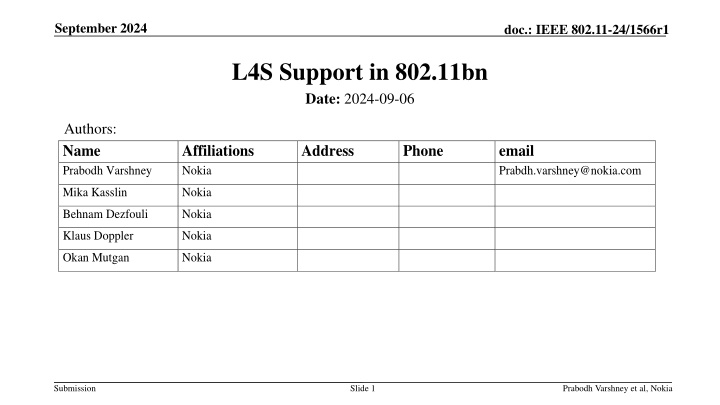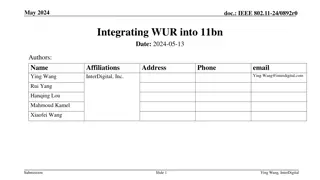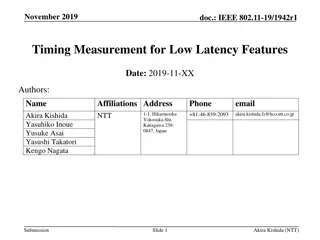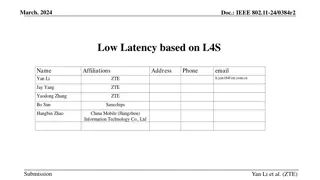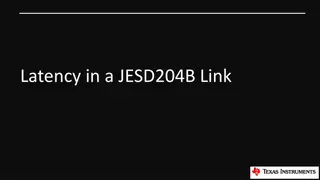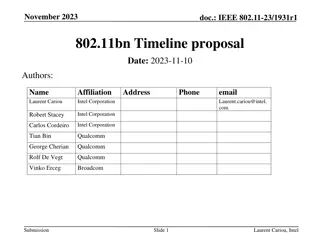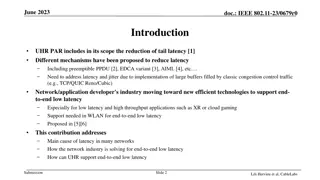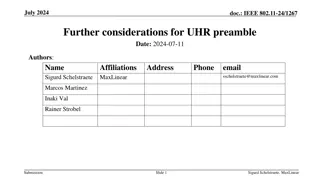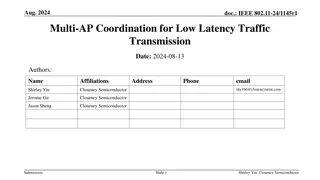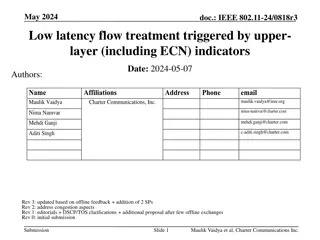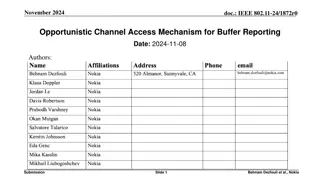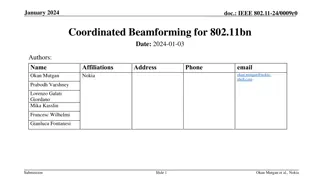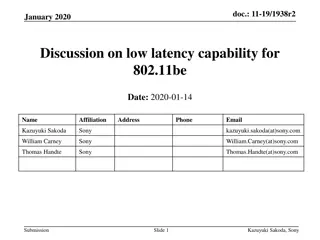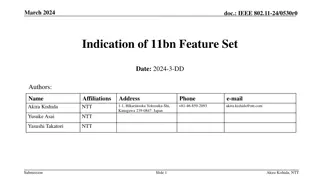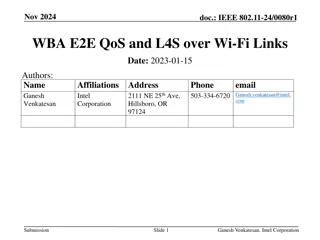L4S Support in IEEE 802.11bn for Improved Latency
This document discusses the proposal for incorporating L4S (Low Latency, Low Loss, Scalable throughput) support in IEEE 802.11bn to enhance end-to-end latency performance in Wi-Fi networks. The focus is on implementing L4S dual-queue Active Queue Management (AQM) at the MAC layer for both AP (Access Point) STA (Station) and non-AP STA, along with congestion experience (CE) marking to enable faster signaling of congestion. The aim is to optimize communication efficiency and ensure seamless support for L4S flows across different network layers.
Download Presentation

Please find below an Image/Link to download the presentation.
The content on the website is provided AS IS for your information and personal use only. It may not be sold, licensed, or shared on other websites without obtaining consent from the author.If you encounter any issues during the download, it is possible that the publisher has removed the file from their server.
You are allowed to download the files provided on this website for personal or commercial use, subject to the condition that they are used lawfully. All files are the property of their respective owners.
The content on the website is provided AS IS for your information and personal use only. It may not be sold, licensed, or shared on other websites without obtaining consent from the author.
E N D
Presentation Transcript
September 2024 doc.: IEEE 802.11-24/1566r1 L4S Support in 802.11bn Date: 2024-09-06 Authors: Name Prabodh Varshney Affiliations Nokia Address Phone email Prabdh.varshney@nokia.com Mika Kasslin Nokia Behnam Dezfouli Nokia Klaus Doppler Nokia Okan Mutgan Nokia Submission Slide 1 Prabodh Varshney et al, Nokia
September 2024 doc.: IEEE 802.11-24/1566r1 Abstract As noted in many earlier contributions including [1-3], L4S is relevant to UHR Wi-Fi as it is designed to provide improved end-to-end latency support In this contribution, we propose 802.11 TGbn to take a step forward and have support for L4S adopted for SFD to meet the requirements set in the UHR PAR We propose the L4S support to be defined based on the selected schemes analyzed and proposed in [2] and [3] 1. L4S dual queue AQM at the MAC for both AP STA and non-AP STA. 2. Congestion Experience (CE) marking at the MAC of a transmitting node with over-the-air signalling support and MAC SAP enhancements Additionally, we would like to have the TGbn to also consider addressing cases in which the peer STA doesn t provide L4S support at the MAC layer but is L4S capable in the upper layers Submission Slide 2 Prabodh Varshney et al, Nokia
September 2024 doc.: IEEE 802.11-24/1566r1 L4S dual queue AQM at MAC We support the proposal of [2] and [3] to have AC_BE and AC_VI to support dual- queue AQM We are in favour of having the dual-queue AQM implemented at the MAC as proposed in option 2 of [3] Higher layer implementation already possible today for sub-optimal performance and with support in 802.11bn we should look for further possible gains We are in favour of always mapping L4S flows to L4S queues Figure source [3] Submission Slide 3 Prabodh Varshney et al, Nokia
September 2024 doc.: IEEE 802.11-24/xxxxr0 CE marking at the MAC Three alternative approaches for CE marking were analyzed in [3] Propose 11bn adopt approach 3 to enable L4S on the MAC This approach enables faster CE signaling by marking packets that have experienced congestion There is less inter-layer signaling and upper layer processing required by receiving node as compared to other 2 approaches Propose approach 1 be used when a peer is only L4S capable at the upper layers Approach 1 Approach 3 Figure source: [3] Submission Slide 4 Prabodh Varshney et al, Nokia
September 2024 doc.: IEEE 802.11-24/1566r1 Summary We support the proposal to have AC_BE and AC_VI to support dual- queue AQM and have the dual-queue AQM implemented at the MAC layer both in AP STA and in non-AP STA We support proposal to always map L4S flows to L4S queues. We support CE signalling at L2 with marking at MAC layer of the transmitting node and related implications to the inter-layer communication and upper layer actions to the receiving side We propose that TGbn also addresses communication with a peer that has no L4S support at MAC Submission Slide 5 Prabodh Varshney et al, Nokia
September 2024 doc.: IEEE 802.11-24/1566r1 Straw poll Do you agree to add the following text to the TGbn SFD: TGbn shall define a mechanism to support L4S. Yes: , No: , Abstain: Submission Slide 6 Prabodh Varshney et al, Nokia
September 2024 doc.: IEEE 802.11-24/1566r1 References [1] 11-23/2065, WNG, End-to-End Congestion Control, L4S and Implications for Wi-Fi [2] 11-23-0679-00-0uhr-low-latency-qos-based-on-l4s [3] 11-24-0399-00-00bn-thoughts-on-l4s-in-wi-fi Submission Slide 7 Prabodh Varshney et al, Nokia
